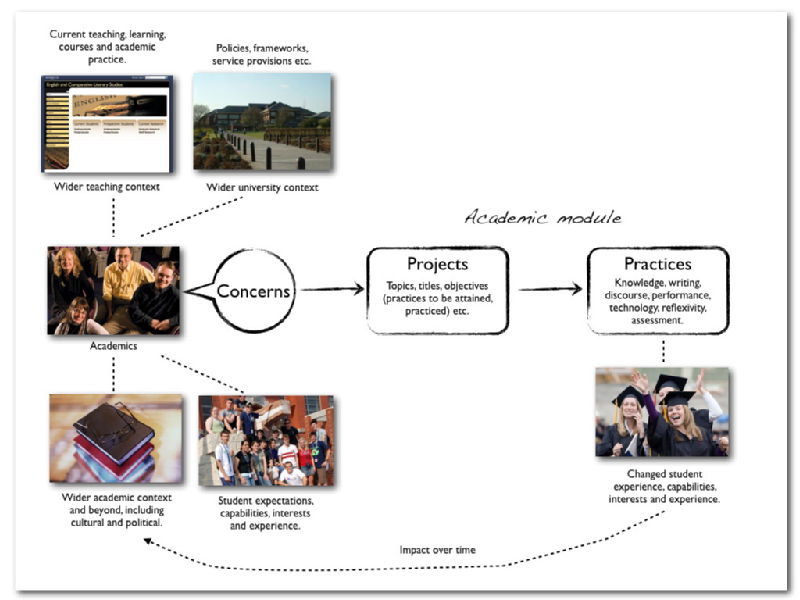All entries for Thursday 12 May 2011
May 12, 2011
Innovating in HE teaching & learning support using participatory design thinking
A brain-dump, which might turn into a full article, and certainly a chapter...
Academic course modules in HE (the standard unit of assessed activity) are conventionally understood as being an assemblage of teaching activities (e.g. lectures), resources (a reading list), and student responses (learning, presentations, essays, exam responses). I have always found that model to be too superficial as a means for designing learning and teaching support and development. It fails to grasp the contentiousness of academic projects. For example, what it means to study and to know seventeenth century literature is contended, and that contentiousness is an important (perhaps the most important) matter to be grappled with by the students. Should students studying 17th C lit go no further than the established canon given in the Norton Anthology? Should they explore authors, texts and contextual issues that might normally be considered to be peripheral? If those lesser-known authors demand a more original and creative response, perhaps using film making and other new technologies, is that allowable within the module? How can the established canon then be reinvigorated using new techniques?
The simplistic model fails to grasp the dynamic, negotiated, 4 dimensional nature of teaching and learning. It overlooks the many points at which the module is actively designed and redesigned. When introducing a new practice, a new technology, it is within this contention rich and ever changing context - practices are contended, and differences may have significant implications. An effective methodology for improving learning and teaching through technology must employ a design strategy that works with this dynamism.
Confused? That's a common response. Choosing or designing technologies to introduce to a module, supporting their integration and use, and measuring their impact, is dependent upon lots of variable local conditions. We most commonly introduce technologies at a more global level, and fail to address their integration into the complex context of the module.
So, here then is a model that is more sensitive to local conditions, contentions, complexities and change. It takes as its starting point a simple model of social agency provided by the sociologist Margaret Archer in Making Our Way Through the World (2007):

To some extent it is idealised. Most modules as taught now are in fact adaptions of existing modules. Not designed from scratch, but redesigned. On the left hand side (in the idealised model), there is a group of academics. They collectively bring together their concerns (as the academic experts) and those of other institutional bodies and people (the course structure, the needs of the discipline, the inadequacy of current practice, the ethos of the university, the students etc), filter that assemblage of concerns into the kind of academic project that we call a module (designed within a given set of affordances and constraints). There are various creative, political and administrative practices that result in a module forming as a project from these concerns. Typically, the module as an academic project is then defined in module handbooks, the prospectus, and verbally to the students at events such as options fares. The module is bounded territorially, and through a set of affordances and a set of constraints. This definition will usually outline:
- The foundational concerns (often in a persuasive or rhetorical manner);
- The sub-projects (lecture topics, essay titles etc)
- A set of appropriate practices (including knowledge, writing and its practices) are explicitly or implicitly defined for the module. They vary between practices with which the student must enter the module, practices that they will develop during the module, as well as practices the development of which are themselves a concern and a goal of the module as a project.
The module is typically expressed as a journey: sign up to the concerns, the project and its practices, and you will get to some better place (better practices, better understanding, or perhaps a better grade). In the humanities, the student is expected to create their own variation of this journey - for example, in creating their own research topic and essay title - as well as, sometimes, critically introducing their own variations on the core practices (for example, introducing a different critical perspective, or using different writing styles).
There are many dimensions of change within this. The most significant being:
- The student will develop new/better/more useful practices.
- The practices upon which the module is based will change (over time, as a result of student and teacher innovation).
- A wider impact may trickle out, eventually changing the department, the discipline, the university, society and culture.
What does this mean for learning technologists and others? The service improvement process needs to be driven by some form of common ground drawn from these innovation processes as they happen in the wide diversity of modules. But also, any intervention at a global level (for example introducing a technology across a whole university) should be accompanied by assistance to co-adapt the innovation with the constant multi-dimensional innovation happening at the heart of module based teaching and learning. Sounds like a cue for participatory design thinking.
As a diagram:

 Robert O'Toole
Robert O'Toole

 Please wait - comments are loading
Please wait - comments are loading



